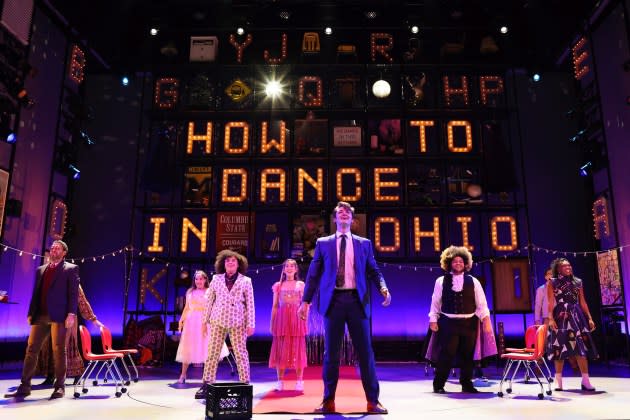Macy’s, Hilfiger on Broadway for Autism Awareness
- Oops!Something went wrong.Please try again later.
- Oops!Something went wrong.Please try again later.

Raising awareness about autism, Macy’s Inc. and Tommy Hilfiger Corp. are among the supporters of the new Broadway musical “How to Dance in Ohio,” which spotlights the talents of seven autistic individuals playing the lead roles.
The show premiered Sunday at the Belasco Theatre and has been in previews for three-and-a-half weeks, but millions got a glimpse when the cast performed a segment during the Macy’s Thanksgiving Day Parade.
More from WWD
The show is about a group of young autistic adults in a social skills therapy group, preparing for a formal dance as part of their therapy, and dealing with all the pressures that come with that, be it asking someone out for the dance, shopping for the perfect dress, or practicing how to dance. As a high-profile platform for autistic actors, the Broadway show is a first.
“How To Dance In Ohio” is inspired by Alexandra Shiva’s documentary of the same name, and was the brainstorm of the show’s composer, Jacob Yandura, who saw the documentary and immediately thought it had to be a musical. The show was originally developed by the late, legendary Broadway director Harold Prince and performed at the Syracuse Stage in the fall of 2022.
Macy’s collaborated on scenic design elements, provided dresses, tuxedos and mannequins, and is depicted in one of the scenes involving shopping. Macy’s has also provided branding, window displays and social media, and will sponsor the opening night party. On Thursday, Macy’s Live, the store’s platform for live shopping, will get behind the scenes with cast members.
“Macy’s has always had a love affair with Broadway,” said Tony Spring, Macy’s Inc. president and CEO-elect. “We are proud that we can continue this legacy by partnering with How to Dance in Ohio. The show touches the heart.”
For the show, Hilfiger provided clothing from the brand’s collection, including adaptive sensory-friendly clothing focused on how fabrics feel on people’s skin, such as styles that don’t have tags in the back and specially made zippers.
“We are deeply committed to raising awareness and supporting programs that shine a light on the incredible skills and abilities of people with autism. We are honored to support the production and provide clothing from the brand’s adaptive and sportswear collections for the cast,” said Hilfiger. “Our family has been affected by autism, and as the father of autistic children, I have experienced first-hand the difficulties of getting dressed. It inspired me to create our Adaptive line with the goal of providing fashionable clothing featuring innovative design twists that make dressing easier and empower adults and kids to feel freedom and confidence.”
“We have seven children between us, and of them, three have been diagnosed with autism spectrum disorder so we have a broad experience with it,” said Hilfiger’s wife, Dee Ocleppo Hilfiger. “Compassion, acceptance, patience, and love is what is needed on all fronts when it comes to autism. We work with a number of different organizations that support individuals with autism and Tommy sits on the board of Next for Autism. Knowledge is power, so we feel it’s extremely important that research is prioritized to advance understanding of the spectrum.”
“Both Macy’s and Tommy Hilfiger are corporate sponsors of the show. They decidedly put their names behind the show and have been able to provide a lot of inventory and support to help,” said Ben Holtzman, cofounder and producer of P3 Productions, which produced the show. “It’s really important to have corporate America behind this show. There’s such a wealth of creativity and expertise there, and it’s important for them to blast the importance of the arts in lifting up an underrepresented community.
“I wouldn’t say there were really any challenges different from working on a typical Broadway show, but we made an effort to be proactive and create a space for this community to do their best work,” Holtzman said. “We sent out a simple access needs Google form to understand what they needed to do their best work, to the autistic cast members and others. They came back to us saying that nobody ever asked before what they needed,” on other productions. “This taught us how to show support. It developed a level of trust where people felt comfortable.” He said the autistic cast members requested such things as a quiet space and sensory items for stimming.
“It can be crazy trying to build a new musical, particularly one where there is no big superstar, and is based on a documentary that received a lot of acclaim, won a Peabody Award, but is not universally known,” said Holtzman. “But Broadway is supposed to be the place for new artists to try new ideas. The seven stars, the director the choreographer and the author are all making Broadway debuts. The rest of the company are all Broadway vets.”
The seven autistic actors are Desmond Edwards, Amelia Fei, Madison Kopec, Liam Pearce, Imani Russell, Conor Tague and Ashley Wool. The book and lyrics are by Rebekah Greer Melodic; Sammi Cannold directed, and the choreography is by Mayte Natalio. Ava Xiao-Lin Rigelhaupt served as autistic creative consultant with Becky Leifman as director of community management.
“The autistic community is greatly misunderstood,” said Holtzman. “The autism spectrum is vast. Experiences are so individual. In ‘How to Dance in Ohio’ we are showing seven very different autistic experiences.”
Best of WWD
